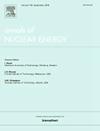Adjusting JEFF-3.3 actinide data using a new, dedicated methodology for selecting suited assimilation database parameters
IF 1.9
3区 工程技术
Q1 NUCLEAR SCIENCE & TECHNOLOGY
引用次数: 0
Abstract
A general method is proposed to choose, among several benchmarks, suitable assimilation database parameters to be used in adjustments. All these benchmarks are predetermined keeping in mind specific goals of the data assimilation. The main principle of the novel methodology is that of excluding groups of strongly cross-correlated computed parameters by estimating their posterior values of . The assimilation tries minimizing the mean for the entirety of the considered benchmarks, including those target parameters which are not part of the selected assimilation database.
The methodology currently applied to the JEFF-3.3 library, is demonstrated by adjusting data for 235U, 238U, 239Pu and 240Pu in conjunction with a class of integral parameters (effective multiplication factors) of fast criticalities including the Godiva and Jezebel spheres, for which the effect of varying resonance parameters in the calculations may be largely neglected.
The computed mean of 36 values in total, among which seven refer to the assimilation database, is halved, and the variance of the individual -values decreases by a factor of 6 with respect to the prior values. More explicitly, the posterior values of respectively 1.10 and 3.77 for and the variance of the individual -values are much smaller than the corresponding prior values of 2.32 and 22.38, which is significant.
As regards the adjustment, for 235U, it is found that and the inelastic scattering cross-section respectively decrease by maximum 3% and 2.6%; is uniformly decreased by maximum 0.053% and the fission spectrum is somewhat harder. For 238U, increases by maximum 5.4% and the inelastic scattering cross-section is lowered by 1%. For 239Pu, is uniformly increased by maximum 0.027% and the fission spectrum is slightly softer. For 240Pu, the fission cross-section is decreased by maximum 3.9%. The proposed adjustments are well within the uncertainty limit of one standard deviation for the nuclear data.
求助全文
约1分钟内获得全文
求助全文
来源期刊

Annals of Nuclear Energy
工程技术-核科学技术
CiteScore
4.30
自引率
21.10%
发文量
632
审稿时长
7.3 months
期刊介绍:
Annals of Nuclear Energy provides an international medium for the communication of original research, ideas and developments in all areas of the field of nuclear energy science and technology. Its scope embraces nuclear fuel reserves, fuel cycles and cost, materials, processing, system and component technology (fission only), design and optimization, direct conversion of nuclear energy sources, environmental control, reactor physics, heat transfer and fluid dynamics, structural analysis, fuel management, future developments, nuclear fuel and safety, nuclear aerosol, neutron physics, computer technology (both software and hardware), risk assessment, radioactive waste disposal and reactor thermal hydraulics. Papers submitted to Annals need to demonstrate a clear link to nuclear power generation/nuclear engineering. Papers which deal with pure nuclear physics, pure health physics, imaging, or attenuation and shielding properties of concretes and various geological materials are not within the scope of the journal. Also, papers that deal with policy or economics are not within the scope of the journal.
 求助内容:
求助内容: 应助结果提醒方式:
应助结果提醒方式:


